Oriental Shorthair
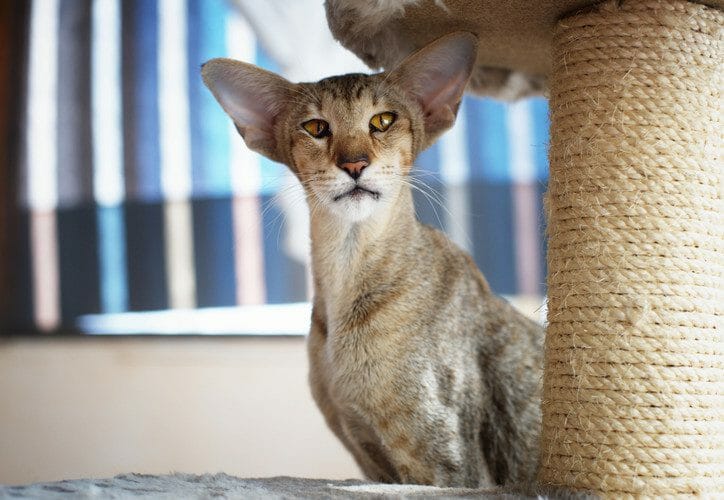
Oriental Shorthair Personality
Intelligent, curious, and chatty, Oriental Shorthair cats are known to get very attached to their humans. These felines crave attention and companionship and will not thrive if left alone for long periods of time. These cats do best in busy, active households where they have constant companionship. If an Oriental Shorthair will be left alone for long stretches, it is recommended that another cat with high social needs be there to keep it company.
Because of their lively personality and curiosity, Oriental Shorthairs can get into trouble if left without diversions. These curious felines have been known to open drawers, rifle through purses, and jump on top of the refrigerator. A variety of games and entertainment are needed to keep these cats entertained and satisfied. Because these felines tend to become extremely attached to one person, they need daily one-on-one time with their chosen human.
Oriental Shorthairs get along with other cats, dogs, and children. They will be quick to greet new people and love being the center of attention. They will become withdrawn and depressed if they do not receive adequate social interaction.
Oriental Shorthairs (like Siamese) are quite vocal—expressing their emotions with a variety of sounds. They are known for their “honk”—a descriptor of their unusual cry. These felines will tell their owners what they are thinking and feeling. These cats would not be a good fit for a household that wants a quiet and shy cat.
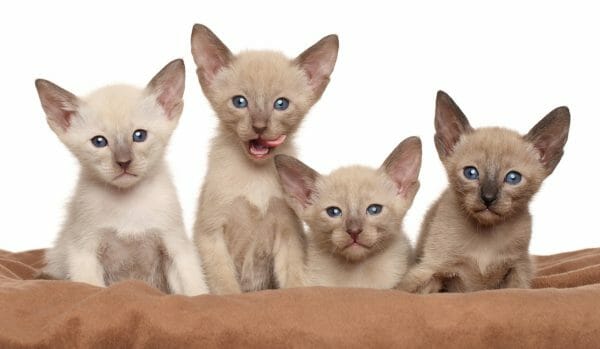
Oriental Shorthair Characteristics
The most striking feature of the Oriental Shorthair is their triangular heads with long noses and almond-shaped eyes topped with large, upright ears. Although considered medium-sized cats, their long, slim, and muscular bodies make them seem taller than they are. Their short hair is glossy and soft and close to the body. Eye color can be blue, green, gold, yellow, or odd (e.g., one blue, one green).
Oriental Shorthair Cat Size
- Weight: Males weigh between 8 to 12 pounds, and females weigh between 6 to 8 pounds.
- Height: These felines can be 8 to 10 inches tall
- Length: Typically between 12 and 15 inches
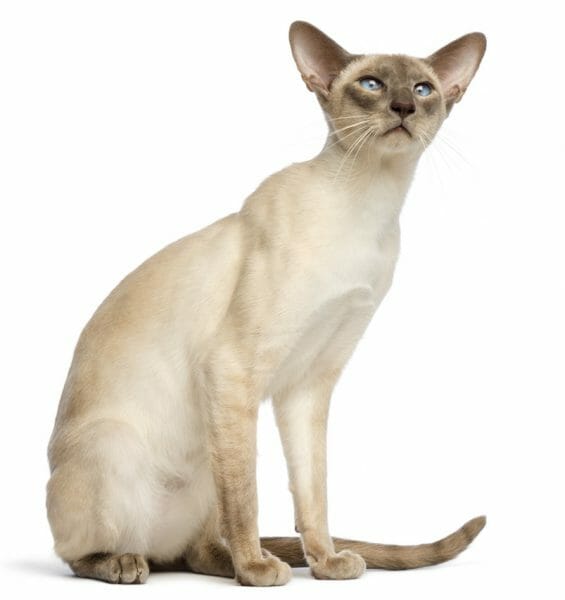
Oriental Shorthair Colors and Patterns
The coat colors and patterns of Oriental Shorthair cats are wildly diverse—with more than 300 color and pattern combinations available. The coat can be a wide range of colors, including white, red, cream, ebony, blue, chestnut, lavender, cinnamon, or fawn.
When it comes to coat patterns, variations include:
- Solid
- Shaded (solid undercoat with color on the tips of the hair)
- Smoke (silver undercoat in all but white cats)
- Parti-Color (solid color with patches of red or cream)
- Bi-Color (white underside, legs, and chest)
- Classic, mackerel, spotted, ticked, or patched tabby patterns
In short, Oriental Shorthairs come in a dizzying array of colors and patterns—making for an amazingly diverse appearance.
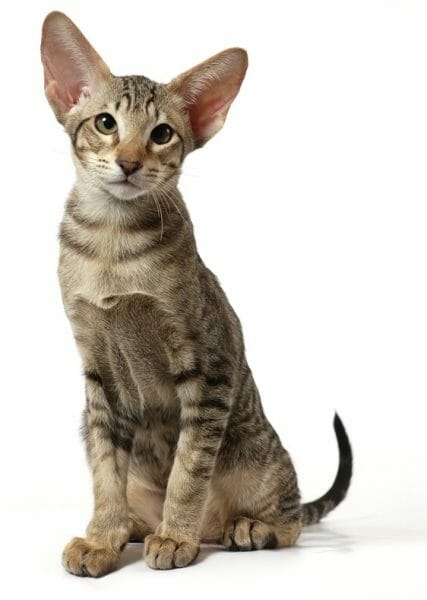
Facts About Oriental Shorthair Cats
Below are some interesting facts about Oriental Shorthair cats.
- This breed is nicknamed the “Ornaments” and the “rainbow cat” for their wide array of coat colors and patterns.
- Because of the breed’s tendency to get quickly and highly attached to people, they must be socialized early. They will insert themselves into everyday activities (whether they are wanted or not). This need to be close earned them the descriptor of “Velcro kitty.”
- Oriental Shorthairs are born entertainers and highly intelligent—a combination that allows their owners to teach them tricks.
- In the book Star Trek Cats by Jenny Parks, Spock’s cat is an Oriental Shorthair.
- The Oriental Cat Association (OCA) was formed in 1971 and is devoted to the breeding and showing of Oriental Cats.
- Tina Gonzalez has owned multiple Oriental Shorthair cats who have achieved fame on Instagram and YouTube. Gonzalez’s cat Stache became a viral sensation when his resemblance to various mustached celebrities—such as Tom Selleck, Groucho Marx, and Charlie Chaplin—was noticed.
History and Background
The Oriental Shorthair is a newer cat breed that was developed in England during the 1950s. English breeders began crossing Siamese cats with other cat breeds, most notably Russian Blues, British Shorthairs, Abyssinians, and other domestic shorthair cats. This breeding effort was a response to a decline in the Siamese cat population after World War II. Any crosses that produced Siamese-pointed kittens were used to continue the Siamese line, while all other variations were grouped together to form the Oriental Shorthair breed. This is why these felines share so many characteristics with Siamese cats.
The breed was introduced to the United States in the 1970s. The Cat Fanciers’ Association (CFA) granted the breed championship status in 1977. Additional breeding with Balinese cats eventually led to the development of the Oriental Longhair cat.
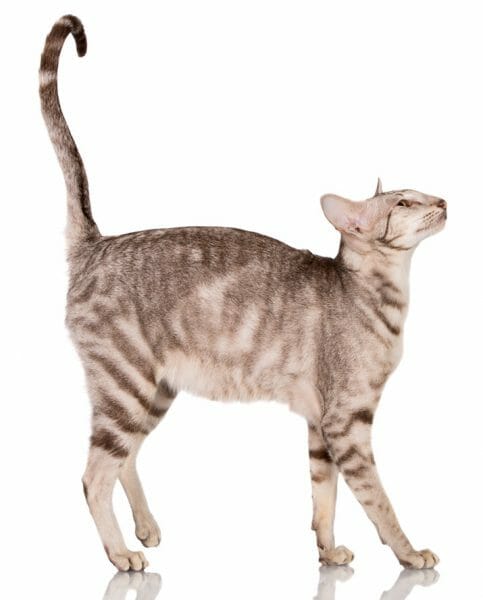
Caring for the Oriental Shorthair Cat
Grooming Requirements
Weekly brushing is all that is needed, along with a quick rubdown with a damp cloth to remove loose hairs. Nails should be trimmed as needed, usually every two weeks. Regular toothbrushing to prevent periodontal disease is recommended.
The biggest grooming requirement focuses on the Oriental Shorthair’s large, bat-like ears, which should be checked weekly for wax, debris, or anything unusual. Regular ear cleaning with a wet cotton ball will help keep the ears clean and healthy.
Exercise
Oriental Shorthairs have loads of energy and intelligence so they need many outlets to keep them out of trouble. A variety of interactive cat toys and teaser toys are requirements, and cat trees and perches are a must. One-on-one playtime is critical for these social cats, who can be taught to play games like fetch. They can also be taught to walk on a leash.
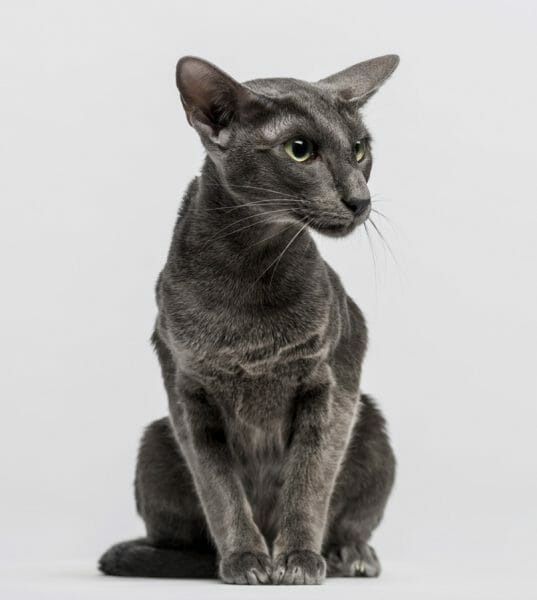
Health Issues
The Oriental Shorthair cat lifespan averages 12 to 15 years. Overall, these felines are healthy. However, as with all cats, routine check-ups with a veterinarian are recommended. Oriental Shorthair kittens should be protected with all recommended core vaccines, including the FIV and distemper vaccines. Owners can prevent obesity by feeding these felines high-quality cat food and providing regular play and exercise time.
Some possible health concerns for Oriental Shorthair cats include:
- Amyloidosis—an inherited condition that results in an abnormal collection of proteins in organs such as the liver and kidney
- Progressive retinal atrophy—another genetic condition that causes gradual vision loss
- Dilated cardiomyopathy
- Bladder stones
- Mast cell cancer
- Crossed eyes




